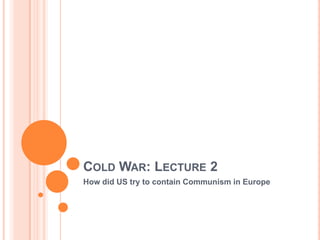
Bmc hist unit4.1_cold war
- 1. COLD WAR: LECTURE 2 How did US try to contain Communism in Europe
- 2. AGENDA OF THE LESSON By the end of the lesson, you would be able to: Appreciate the: Truman Doctrine, The Marshall Plan and NATO The benefits of such approaches The draw backs of containment
- 3. THE TRUMAN DOCTRINE, MARCH 1947 Soviet expansion in Europe increasing - US and allies. Truman decided that US must prevent this. Under the Truman Doctrine USA would: prevent Communism from spreading help any country , threatened by Communism Put his doctrine into action by: Giving money & weapons to Greece and Turkey which were in danger of being taken over by communists - able to stop the spread of communism with US aid. Stalin responded - formed the Communist Information Bureau (COMINFORM) – alliance of Communist parties to keep Communist Bloc countries together.
- 4. MARSHALL PLAN, JUNE 1947 Another way of containing communism – through offering financial aid to Europe. Plan was named after George Marshall who directed it. Aims of the plan help Europe recover economically from WWII build a prosperous Western Europe – able to resist Communism.
- 5. MARSHALL PLAN, JUNE 1947 US Containment Policy: By making Europe rich and strong again, he would help to create stable, Capitalist, democratic governments in Europe. US believed that with the Marshall Plan – people in in Europe would become more prosperous and therefore not support Communism.
- 6. MARSHALL PLAN, JUNE 1947 Details of the Plan: 16 countries in Western Europe agreed to the Marshall Plan. Between 1948-1952 these countries – received $13 billion in aid, loans and goods. Marshall extended aid to East Europeans. Stalin refused – felt that the Plan – was aimed at extending influence there. Soviets formed an organization that would encourage trade between Communist states in Europe. COMECON did not really improve the economies of these states. Benefits Western government still recovering – still better than large skins Marshall Plan also divided European economies into halves - heightened tensions
- 7. NATO (NORTH ATLANTIC TREATY ORGANIZATION) Europe was divided into two spheres of influence: The Communist and Capitalist spheres. US & USSR – forced to seek military allies. US tried to increase their forces in Europe – set up NATO. NATO – a military alliance formed by US and 11 other countries. Its aims were: To defend Europe from Soviet attack. Attack on European allies by Soviets would be considered an attack against all.
- 8. NORTH ATLANTIC TREATY ORGANIZATION 1955 - USSR decided that it would set up Warsaw Pact. All communist countries in Europe (except Yugoslavia) joined the Warsaw Pact. Benefits of NATO/Warsaw Pact: NATO and the Warsaw Pact protected the member states but; Also heightened tensions in Europe during the Cold War. The US was contented that the Truman Doctrine, Marshall Plan and NATO could contain Communism within Europe.
- 9. OUTCOMES OF CONTAINMENT World War II alliance between Britain, US and USSR after 1945 not close – mutually suspicious of each others intentions. USSR viewed US moves in Europe as trying to establish control there. Containment helped to check Soviet expansion into Western Europe. However, also increased tensions in Europe as: both sides tried to gain allies to bolster their defenses against possible attacks from the other.
- 10. CRISIS IN EUROPE – BERLIN BLOCKADE Conflicts over how to administer Germany led to a crisis between Britain, France, US and USSR in 1948. Germany divided into four zones. Berlin – also divided into four zones. The four countries agreed to administer Germany together under a joint administration.
- 11. MAP OF GERMANY AND BERLIN (1948)
- 12. BERLIN BLOCKADE In 1948: Britain, France and US joined their separate zones in Germany and also created a new currency for Germany. These actions helped the West German economy to recover – Western powers also encouraged free elections in West Germany. Stalin was fearful that the West would make Germany strong again and threaten Russia.
- 13. BERLIN BLOCKADE – STALIN’S STRATEGY Stalin planned to seize control over the whole of Berlin – by blocking off road, rail and canal links between East and West Germany – June 1948. He thought of forcing the allies to leave Berlin by blocking off all supplies.
- 14. BERLIN BLOCKADE – US STRATEGY US felt it was important to support West Berlin because: Berlin represented the democratic system. Concerned that if it pulled out of Berlin – Soviets would be emboldened and attack the whole of West Germany. Yet the US and allies were very cautious – could not start a full scale war by sending in troops to lift the blockade.
- 15. BERLIN BLOCKADE – LIFTING THE SIEGE To avoid war, Pres. Truman ordered a fleet of planes to fly over Berlin and drop food supplies and other supplies into Berlin. Over 10 months – 2 million tons of supplies were flown into West Berlin. About 2.5 million Berliners were kept warm throughout the winter of 1948. After 10 months – Stalin realized that Blockade was a failure – West was determined to support West Berlin – called off the blockade in May 1949
- 16. BERLIN AIRLIFT
- 17. CONCLUSION War time alliance was at an end – US and allies were mutually suspicious of each other. US and USSR locked in a struggle to gain allies and influence in Europe (later the world) These tensions did not escalate (become worse) because both sides were fearful of starting another war – Europe still recovering from WWII. Both sides preferred to use threats and “challenge” each other – but these never amounted to direct military actions.
